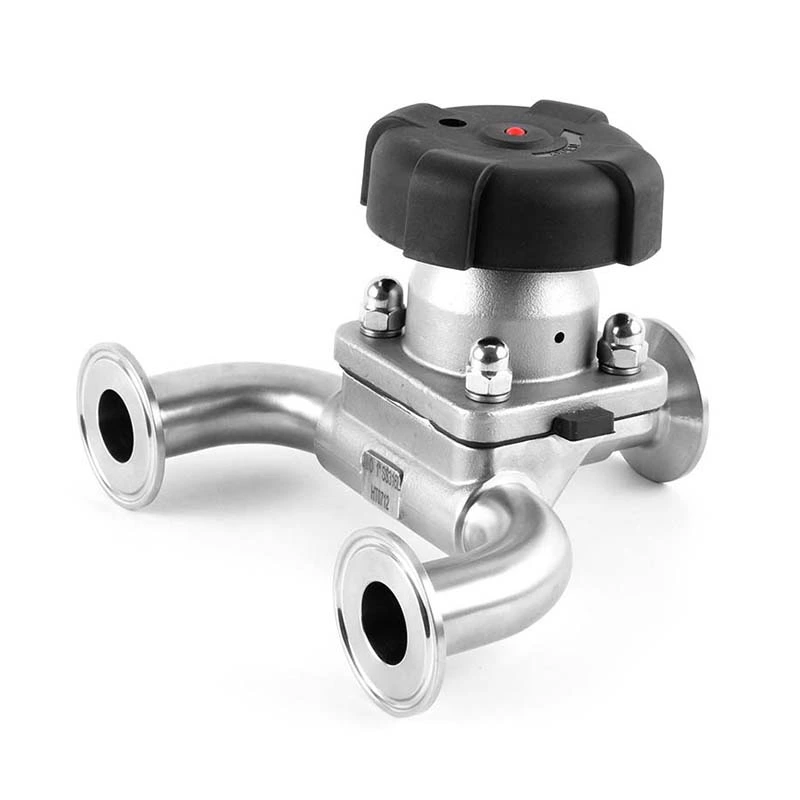Popularization Of Relevant Knowledge Of Diaphragm Valves
Sanitary Diaphragm Valve is a stop valve that uses a diaphragm as a start and close component to close the flow channel, cut off the fluid, and separate the inner cavity of the valve body from the inner cavity of the valve cover. The diaphragm is usually made of elastic, corrosion-resistant, and non-permeable materials such as rubber and plastic. The valve body is mostly made of plastic, fiberglass, ceramic or metal-lined rubber materials. It has a simple structure, good sealing and corrosion resistance, and low fluid resistance. It is used for low-pressure, low-temperature, highly corrosive media and media containing suspended matter. According to the structural form, there are ridge type, stop type, gate type, etc. According to the drive mode, there are manual, pneumatic, and electric.
The structural form of the diaphragm valve is very different from that of a general valve. It is a new type of valve and a special form of shut-off valve. Its start and close component is a diaphragm made of soft material, which separates the inner cavity of the valve body from the inner cavity of the valve cover and the drive components. It is now widely used in various fields. Commonly used diaphragm valves include rubber-lined diaphragm valves, fluorine-lined diaphragm valves, unlined diaphragm valves, and plastic
Diaphragm valves
A diaphragm valve is a valve body and a valve cover equipped with a flexible diaphragm or a combined diaphragm, and its closing member is a compression device connected to the diaphragm. The valve seat can be a weir-shaped or a pipe wall of a straight-through flow channel. The advantage of a diaphragm valve is that its operating mechanism is separated from the medium passage, which not only ensures the purity of the working medium, but also prevents the possibility of the medium in the pipeline impacting the working parts of the operating mechanism. In addition, no separate seal is required at the valve stem unless it is used as a safety facility in controlling harmful media. In a diaphragm valve, since the working medium contacts only the diaphragm and the valve body, both of which can be made of a variety of different materials, the valve can ideally control a variety of working media, especially for media with chemical corrosiveness or suspended particles. The operating temperature of a diaphragm valve is usually limited by the materials used for the diaphragm and the valve body lining, and its operating temperature range is approximately -50 to 175°C. The diaphragm valve has a simple structure and consists of only three main parts: the valve body, the diaphragm and the valve head assembly. The valve is easy to disassemble and repair quickly, and the replacement of the diaphragm can be completed on site and in a short time.
Today I will introduce you to the diaphragm valve, which is a cut-off valve that uses an elastic diaphragm as an opening and closing part and a seal. It appeared in the 1920s. Diaphragm valves can be divided into six types according to the structural form: house type, direct current type, stop type, straight-through type, gate type and right-angle type.
This diaphragm valve uses a corrosion-resistant lined valve body and a corrosion-resistant diaphragm to replace the valve core assembly, and uses the movement of the diaphragm to play a regulating role. The valve body material of the diaphragm valve is cast iron, cast steel, or cast stainless steel, and is lined with various corrosion-resistant or wear-resistant materials, diaphragm materials rubber and polytetrafluoroethylene. The lined diaphragm has strong corrosion resistance and is suitable for the regulation of highly corrosive media such as strong acids and alkalis.
The equipment has a simple structure, low fluid resistance, and a larger flow capacity than other types of valves of the same specification; there is no leakage, and it can be used for the regulation of high viscosity and suspended particle media. The diaphragm isolates the medium from the upper cavity of the valve stem, so the medium will not leak out without packing. However, due to the limitations of the diaphragm and lining materials, the pressure resistance and temperature resistance are poor, and it is generally only suitable for 1.6MPa nominal pressure and below 150℃.
It has the following characteristics:
1. Small fluid resistance.
2. It can be used for media containing hard suspended matter; since the medium only contacts the valve body and the diaphragm, there is no need for a stuffing box, there is no problem of stuffing box leakage, and there is no possibility of corrosion to the valve stem.
3. It is suitable for corrosive, viscous, and slurry media.
4. It cannot be used in high pressure occasions.
Well, the above is what I did for you today. The relevant knowledge about diaphragm valves has been popularized. Have you learned it? After reading this article, do you know more about this product? I also hope that this article can be helpful to everyone.
